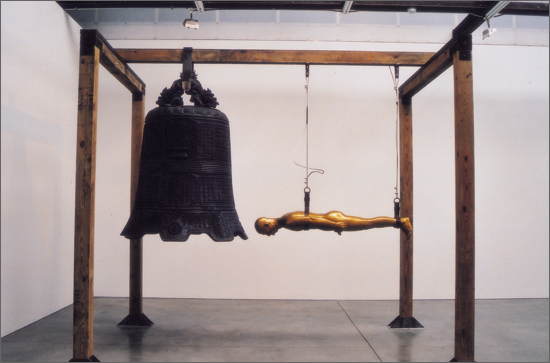|
By Roselee Goldberg
Artforum, March 2002

Peace, 2001, Cast Bronze and Wood, 11x12x8 Ft
Zhang Huan At Luhring Augustine
While Zhang Huan was an art student in Beijing in the early ’90s, his art history professor taught him about "Rubens’s red," "the most powerful red in the history of art." Later, when Zhang himself was teaching, he passed along his teacher’s formulation, adding that Ruben’s red is, in fact, multilayered. By contrast, he explained, "Chinese red is flat." Zhang’s sensitivity to the nuances of painting may be surprising, given that he is known for performances that he documents in photographs. But the story indicates his acute awareness of the different approaches to representation in the history of art in his native China as well as in Western Europe and North America, which informs such work as the elegant color photographs and gilded bronze sculpture of the current exhibition and which seems to need little translation from one context or audience to the next.
In the self-portrait Family Tree, 2000, a grid of nine framed photographs, the artist’s face is treated as a blank page for a calligraphic map of an idealized, multi-generational family. The first photograph shows Zhang with his own personality chart written in black ink across his face. In the succeeding images, family stories and popular fables (including "How Yukong Moved the Mountain," the tale Mao used to describe his land-ownership policy) have been added by a calligrapher until in the last image the artist’s face and shaved head are entirely black. Family Tree is a theatrically imposing work that combines forceful images, a high level of craft, and a complicated autobiography articulated via the body.
Peace, 2001, also begins with Zhang’s body. A bronze cast of the artist nude hangs horizontally at eye level from a traditional Chinese four-poster pavilion, the head aimed at the side of a massive bronze bell. Viewers are permitted to push the body headfirst into the bell, which sends a loud bong through the gallery. As peculiarly disturbing as Dennis Oppenheim’s banging his head (actually a puppet of himself) against a bell in an early work, this sculpture makes other connections to body artists of the 70’s, such as Chris Burden and Marina Abramovic. Their performances, in which they took dangerous physical risks, inspired Zhang to extreme acts himself. In 12 Square Meters, 1994, he sat for one hour covered with flies in a filthy latrine in Beijing, in silent protest against the infested public toilets of that city; and in 65 Kilograms, 1994, he had himself suspended naked by chains from the ceiling of his one-room apartment. Doctors attached a catheter to a vein, from which his blood dripped slowly into a metal bowl on the floor, heated to concentrate the stench of blood in the confined space. His so-called self-torturing was a highly personal response to a repressive government and a way for him, he has said, to release his fear of that regime.
Less threatened now-he has a home in New York, and when he visits China he is welcomed by an internationally oriented art scene-Zhang has moved beyond the urge for self-destruction. His performances outside China are ritualistic and metaphorical rather than masochistic. No longer single actions, they are choreographed events with seven or eight brief scenes executed by casts of twenty to fifty performers. Their subject matter is frequently a distillation of the geographies that the peripatetic artist has encountered: My America, 1999, and My Australia, 2000, for example, demonstrate his emphatically Chinese view of Western cultures. Remarkably, his latest sculptures and photographs, with their edgy sensuality, express the essence of his own history as an artist. They also show him to be one of a very few artist able to successfully translate the ethos and aesthetic of live performance into solid objects for contemplation. |